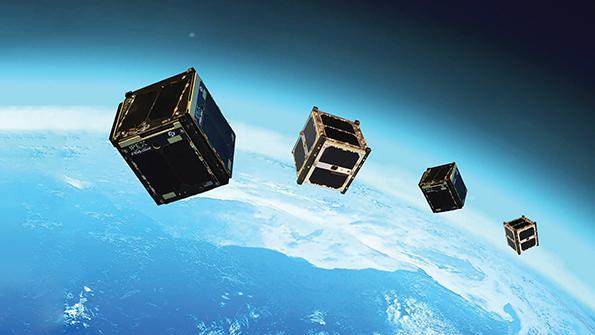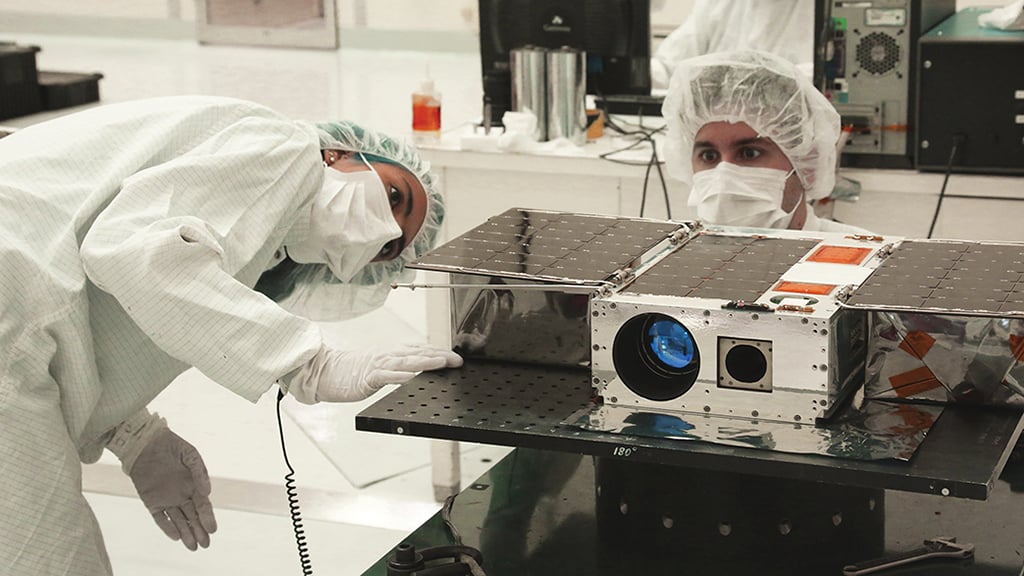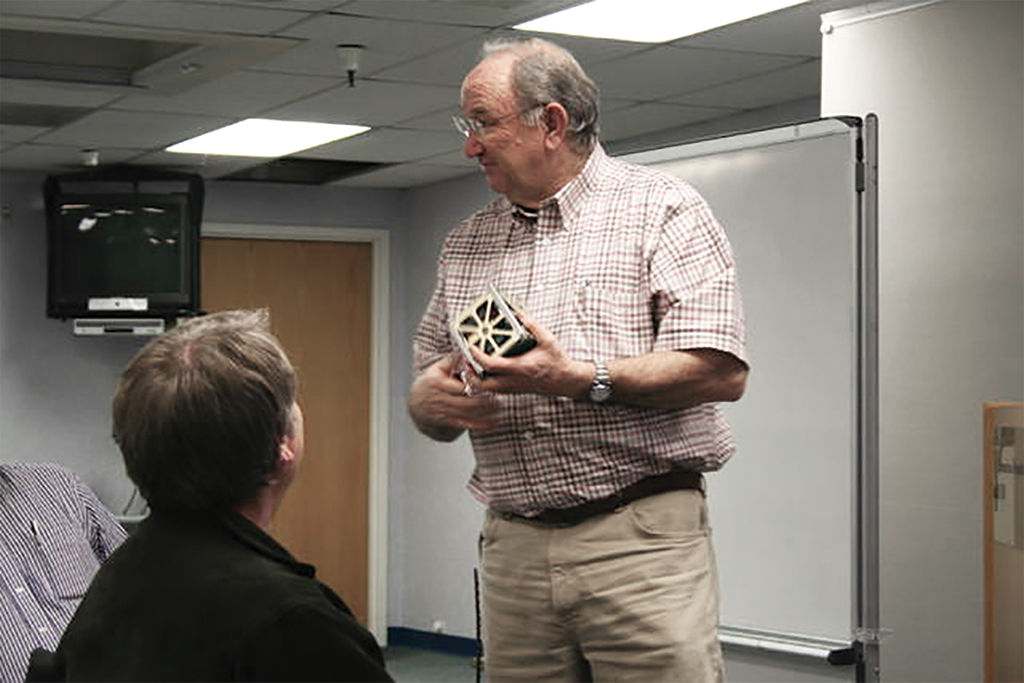
NASA has embraced cubesats after an initial reluctance.
Bob Twiggs was frustrated. His Stanford University graduate students started satellite-building projects but never finished them.
The students came and went. Launch opportunities were lost. There was not enough time. “I had to do this in one year, because most of the students I worked with are master’s degree students,” says Twiggs, who has since retired after later teaching at Morehead State University.
- NASA was initially reluctant to embrace the small form factor
- Dozens of cubesat companies are founded every year
Searching for a way to simplify the projects—and cut out build time—Twiggs thought, “What if we made [the satellite] a cube and put solar cells on all sides so no matter which way it rotated, it was going to get charged?” With some spare solar cells from NASA’s Jet Propulsion Laboratory, he went down to a local shop and found a 4 X 4 X 4-in. transparent box.
“At the time, they put Beanie Babies in it. That was the big craze,” Twiggs says. “I bought a Beanie Baby box, tried it with solar cells, and it fit pretty well.”
It was also around that time—in 1999—that an infamous error caught Twiggs’ attention. That year a mix-up between Imperial and metric units by a Lockheed Martin engineering team caused NASA’s Mars Climate Orbiter to burn up in the red planet’s atmosphere, ending the mission early.
“I said, ‘It’s about time students learn metric,’” he says. “I wonder what this [4-in. box] is in metric? Well, it turned out to be just almost 10 cm.”
Twiggs sent the 10 X 10 X 10-cm box idea to co-inventor Jordi Puig-Suari, an aerospace engineering professor at California Polytechnic State University, who thought he was onto something.
“That’s where Jordi made the difference. It took a lot of effort on his part,” Twiggs says. “Jordi wrote up the specifications and published them. Then they worked on the P-POD [Poly-Picosatellite Orbital Deployer] and got that developed. And then they worked with a whole bunch of people to try and find a launch.”
What Twiggs and Puig-Suari invented together is now known as the cubesat standard. Since the first launch in 2003, nearly 2,000 cubesats have made it to space, according to the Nanosats Database. An entire industry has sprung up around the 10 cm3 form factor, with multibillion-dollar companies embracing the satellite type as well as space agencies such as NASA, which now use the small satellite for complex deep space missions.
The origin story of the cubesat is as unassuming as its professorial inventors. A teaching tool, cubesats were initially ridiculed and sparsely funded. The story of their rise to prominence is the opposite of the billionaires’ space race filling headlines today. Their success also was not a foregone conclusion.
Although the form factor has the hallmarks of standards that have succeeded before it, like the intermodal container that revolutionized the shipping industry, it was not intended to reshape industry.
“I had no idea that it would become an industry standard,” Twiggs says. “It wasn’t any magical thing that I could see the future [and it] was going to be great. In fact, it created more criticism than it created praise, which is kind of neat.”

In the early days, getting the space industry to embrace the concept was a challenge. “A lot of people said: ‘That’s the stupidest idea we’ve ever seen.’ And we said: ‘Oh, that’s OK. It’s for education,’” Twiggs says.
U.S. launch providers were not interested in launching tiny satellites as secondary payloads. The spacecraft did not bring much revenue and risked collisions with primary payloads that cost hundreds of millions of dollars, says Aaron Zucherman, a recently graduated doctoral student in systems engineering from Cornell University who is interviewing early cubesat developers and is in the initial stages of writing a book on the history of the satellite type.
“The large companies didn’t care unless you had hundreds of millions of dollars and you were buying the whole rocket,” he says. “The idea of rideshare as a service was not there. They weren’t interested.”
It was not until about four years later, in 2003, that the first batch of six cubesats launched on a Russian Rokot, an intercontinental ballistic missile converted into a space launch vehicle. The vehicle was operated by Eurockot Launch Services, a joint venture between ArianeGroup and the Khrunichev State Research and Production Space Center, with the launch organized by Space Flight Laboratory. The attitude of the Russians toward adding cubesats to the Rokot launch vehicle was: “‘OK, we’ll do whatever you want as long as you pay for it,’” Zucherman says.
Risk-taking and a whatever-it-takes attitude are at the core of the cubesat’s success. Students often had to scrounge for donated parts from aerospace vendors, Twiggs says. “The commercial people were really good,” he notes. “They’d say: ‘I wish I’d had something like that when I went to school.’ So [the students] were able to get a lot of parts to put these things together.”
Even with all the parts, sometimes cubesats did not come together as planned. Twiggs recalls a group of students struggling and failing to fit their cubesat into a deployer.
“One of the students got so tired of this [and said]: ‘If we can’t make this fit, we’re going to throw it in the canal.’ They went back to their hotel, and they took a gun file, filed down the rails and brought it back and it fit,” Twiggs says. “NASA would never let you do that. NASA would say: ‘You’re gonna do what? You have to go back and requalify this.’ So that’s how the space program has changed. By golly, that’s pretty cool.”
Early cubesat developers were not constrained by a lack of knowledge, Zucherman says. “They didn’t know what they didn’t know. They weren’t deterred because it wasn’t just an acceptance of risk; it was also a kind of ignorance of risk,” he says. “They didn’t have the NASA safety handbook that they had to comply with, because [NASA] knew every single thing that could go wrong with a satellite or a rocket.”
There is also something about building and launching an object into space that gets students to spend hundreds of hours of their free time working on cubesats, Zucherman says. “If they just beeped a few times—if they were literally just Sputniks—that was an amazing opportunity,” he says. “It wasn’t that they were willing to take the risk. It was that they were working on a project because they loved it and they were going to see it to the end no matter what.”
NASA was skeptical of cubesats at first. The message from the Jet Propulsion Laboratory was: “‘Oh, don’t mess with that,’ Twiggs says, adding: I’m kind of glad. The old saying is, ‘I’m glad that NASA didn’t come along to help us,’ or it would have been much harder to do.”
Ultimately, it took what Zucherman calls a “rogue unit” at NASA Ames Research Center in Mountain View, California, which—despite being told to stop and having its funding revoked—persevered and launched the space agency’s first cubesat in 2006, the GeneSat-1, a microgravity experiment for biological cultures. “That kind of opened the floodgates,” Zucherman explains. “It was important that somebody did the old NASA process of safety [evaluation]. They basically quieted any naysayers.”
With NASA’s demonstration of the technology, launch providers became more open to carrying the type, he says. Shortly after NASA’s first cubesat, in 2007, the Apple iPhone came out, further driving the miniaturization of electronic components and increasing the importance of software. Scientists who could not raise $50 million, $100 million or more to build their dream scientific instruments started to consider miniaturizing their satellite equipment.
“Maybe it’s not 100% or 99% of what you want it to do. Maybe it’s only 75%,” Twiggs says. “But you’re going to get some data before you launch [which otherwise would be] when you have grandkids.”
By the 2010s, Spaceflight Services had started to pioneer the brokering of rideshare missions—buying excess capacity on launch vehicles and then selling rides to small satellites—while also offering spacecraft integration and certification services for the secondary payloads. The company published commercial pricing, making it easier for cubesat developers to plan and budget.

In 2017, the Indian Space Research Organization’s Polar Satellite Launch Vehicle lofted 104 small satellites in a single mission, setting a record and a precedent that inspired future rideshares. In 2021, SpaceX launched Transporter-1, its first dedicated SmallSat Rideshare Program mission, setting a new record with 133 small spacecraft onboard its Falcon 9 launch vehicle. In total, eight Transporter missions have launched to date. Combined with the cost-savings of the partially reusable Falcon 9 launch vehicle, those rideshare missions have increased access to space for cubesats.
Cubesats are being used for an ever-widening number of applications, including Earth observation; weather sensing; alternative position, navigation and timing; communications; and technology demonstration missions, as well as free-flying biology and in-space manufacturing experiments. Some 15 cubesats have been developed for interplanetary missions, according to the Nanosats Database.
Prominent new space businesses, such as Earth-observation company Planet Labs, founded in 2010, and Terran Orbital, founded as Tyvak Nano-Satellite Systems by Puig-Suari in 2011 and a supplier of buses for U.S. Space Development Agency programs, have been built on cubesats. In the last decade, dozens of companies each year have been founded to develop cubesats, according to the Nanosats Database.
The professionalization of the cubesat standard has had consequences, however. “It is much more difficult to get a cubesat launched now than it was when we started,” Twiggs says. Regulations around frequency allocation and deorbit requirements are more burdensome, for instance. “The big guys took it over and kicked us little guys out, and I’m disappointed in that,” he says.
Student cubesat projects have been taken over by the ambitions of their professors, too, he adds. “The problem is that it isn’t what the students want, it’s what the mentors and the professors want,” Twiggs says. “They want to get their Nobel Prize.”
Twiggs argues that universities should go back to the basics. “I’d advocate building something with the students that’s a Sputnik,” he says. “You know what the Sputnik did? It went up there, and it was transmitting on amateur radio frequencies, and it told the temperature and a couple other parameters. But that was it. Isn’t that enough for the students at the very beginning?”
To make it easier for students to launch satellites, Twiggs went back to the drawing board and started work on inventing the PocketQube standard in 2005. The tiny spacecraft measures 5 X 5 X 5 cm (2 X 2 X 2 in.). Its smaller size is intended to reduce launch costs. Then in 2017, he invented the ThinSat standard—a flat satellite about the size of a piece of toast, 21 examples of which can fit into a 3U cubesat launcher. ThinSats and PocketQube standards have seen increased adoption in recent years.
“I’m more of a ‘come up with an idea and other people implement it [type of person],’” Twiggs says. “I’m not the tech guy. I’m the rah-rah coach.”
At the start of the Space Age, most space industry enthusiasts could only watch the achievements of NASA and the Soviet space programs on TV. But Twiggs, Puig-Suari and the cubesat generation democratized the space industry. Now even children in high school are building and launching small satellites. Reaching this point took a bit of irreverence, naivety and youthful enthusiasm.
For Twiggs and many others, the desire to gain hands-on experience with spacecraft long preceded the invention of the cubesat. In 1985, when preparing to launch Nusat 1 (Northern Utah Satellite), Twiggs said he stole a glance at the satellite before its ride on the Challenger space shuttle.
“I snuck into the clean room one night,” he says. “I put my fingers all over that satellite before it flew so I could say I had my fingerprints in space.”






Comments